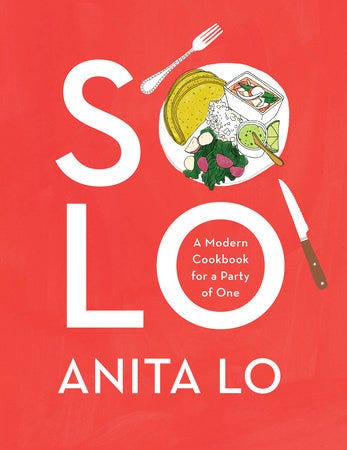After a terrible year, this cookbook is helping me figure out how—and why—to cook alone
I am standing in my mother’s kitchen, aggressively stabbing a sweet potato with a fork, when it occurs to me that I haven’t made a meal for myself in months.
The next day, I’ll make pasta from scratch for the first time. The day after that, broccoli rabe pesto and charred clementines smothered on a slice of crusty French bread. I will learn to enjoy cooking again. I will eat too much. I will feel something resembling pride, or maybe, satisfaction.
But for now, I am stabbing a sweet potato — much harder than I need to, really — in an attempt to nourish myself. I am stabbing a sweet potato because, after a terrible year of grief and loss, it is a weirdly therapeutic thing to do. And I am stabbing a sweet potato because I desperately need to figure out what the fuck self-care looks like.

I’m not alone in this venture: I have a recipe. Underneath my nose, there’s a copy of chef Anita Lo’s latest cookbook, Solo: A Modern Cookbook for a Party of One. As Lo tells it, the idea came about while she was brainstorming punny cookbook titles with a friend on the phone. They cycled through everything from “Lo Country Cooking” to “Lo and Slow: The Braising Book” — until eventually, they landed on “So-Lo,” and something clicked.
For Lo, it was personal: In college, she ate most of her meals alone, a copy of Pierre Franey’s 60-Minute Gourmet close at hand. She didn’t mind the extra effort it took to cook a complicated meal for one — but few people seemed to understand why. “All of my life, I’ve been surrounded by people asking, ‘Why would you go through all of that hassle for yourself?’” she told me over the phone last November. “For me, it’s not that much of a hassle because it’s what I love to do, and I know how to make things easy. But even then, why wouldn’t you go through all that hassle?”
The most obvious answer is that not everyone has a résumé like Lo’s. As the former chef owner of the now-closed Michelin-starred restaurant Annisa, Lo is well equipped to cook up a beautiful meal, whether it’s for one person or one hundred. But she’s also well aware that not everyone shares her particular set of skills — which is why Solo is meant to be accessible for both amateur home cooks (me) and professionals who actually know what they’re doing (Lo).
This is how I find her recipe for twice-cooked sweet potatoes with mushrooms, kale, and Parmesan. It’s an easy enough recipe: After sufficiently stabbing the sweet potato, I wrap it in a damp paper towel and place it in the microwave for a few minutes. I scoop out the soft, fluffy center and mash it with ricotta and Parmesan, before putting it back in the skin to bake in the oven. I sauté kale and baby portabella mushrooms with garlic and thyme, and pile it on top of the sweet potato when it’s finished.
Then, I shovel it down my throat until I can’t eat another bite.
Can loneliness be taught? Can it become a habit? Can it be unlearned? I’m not sure — but for me, it has always been a safety blanket.
I grew up an only child: the sole daughter of a fiercely independent single immigrant mother. From a young age, I learned to keep myself entertained, to take care of things without asking for help. I learned how to be alone — and to enjoy it.
As I got older, the habit stuck.
In many ways, I’m Solo’s target audience: I eat most of my meals alone, and I can’t afford to eat out for every meal. Unlike Chopped, Top Chef Masters, and Iron Chef America veteran Anita Lo, however, I hate cooking for myself.
From a young age, I learned to keep myself entertained, to take care of things without asking for help. I learned how to be alone — and to enjoy it. However, I hate cooking for myself.
So, I often don’t. Instead, I stock up on frozen dinners. I make a second meal out of my work lunch. I order containers of spicy pad Thai, or boxes of thin Neapolitan pizza, and stretch them out over the week. On special occasions, I venture out for the perfect bowl of cacio e pepe, or a basket of xiaolongbao, or tacos al pastor. I relish asking for a “table for one” — which has somehow always felt less depressing to me than eating alone at my tiny kitchen table.
Ordering delivery is easily my most financially reckless habit, and probably one of my most unhealthy. But I continue to do it anyway — in large part, because I don’t think cooking an elaborate meal for one is worth the time or effort. Whenever I do cook at home, it’s usually something simple, something I can whip up in a half hour or less.
This isn’t to say that I hate cooking. In fact, I love it — as long as it’s for other people. But to me, cooking for one has always felt like a game of patience and portions. When I’m alone, every meal feels like a math equation; every trip to the grocery store, an exercise in self-control. In the kitchen, the same soliloquy: Will I grow sick of this dish by Wednesday? Can I freeze it? Should I cut the recipe in half? Will it go to waste if I don’t?
As far as input versus output goes, solo cooking is a scam. After all, most recipes aren’t made for one person — and, as Lo explains, most food items at the grocery store are packaged to reflect this. The entire food chain is made for feeding families, for entertaining friends, for romancing significant others. It isn’t for solo diners whose only company is their empty apartment and a furry friend.
When I’m alone, every meal feels like a math equation; every trip to the grocery store, an exercise in self-control.
But in spite of this, for a lot of people, solo cooking also isn’t a choice. Everyone has to eat — and whether you’re partnered or not, most people have to eat alone at some point in their lives. The ability to feed yourself is an essential life skill, and cooking at home is as much a matter of nourishment as it is one of practicality. With Solo, Lo makes the case for learning how to do it properly.
From a cultural standpoint, what she’s tackling is far more complicated than what first meets the eye. Through a lifetime of film and TV and books, I have been taught that being alone is supposed to be a temporary ailment — that it’s something to be cured. I’ve been shown, time and time again, that eating by yourself is either the pinnacle of loneliness or an irrefutable sign of stubborn, foolhardy independence — particularly if you’re a woman.
This is a narrative that Lo hopes to help change with her latest cookbook. “Cultural shifts happen slowly, and they happen because more people become aware,” she says. “There’ve been studies about how more people are choosing to be alone, or are having to be alone because of what’s happening with how people work these days. I think it’s a natural shift. Eventually we’re going to have to come to terms with [it]: There are a lot of people that eat alone.”
8 Cookbooks You Can Read Like…Books
An essential part of changing the narrative around solo eating, Lo argues, is to change the way we view solo cooking. Rather than think of it as wasted time and effort, or a boring necessity, we should instead view it as an investment in ourselves and our wellbeing. “Food is culture, food is identity,” she says. “It can be very self-reaffirming to eat what you love.”
She’s right, of course — which didn’t stop me from ignoring her advice altogether. After I talked to Lo, I continued down the same path, stretching out meals, rationing groceries, and turning one dinner into three. I continued pushing the most basic act of self-care to the side, and continued feeding myself the “easy,” financially irresponsible way.
And then, a couple months ago, someone I love unexpectedly died of a stroke.
And then, a few weeks after that, someone else I love ended up in the ER; then the next day, another hospital, and the day after that, another.
And then, the rest of my life fell apart — which is how I found myself in my mother’s kitchen, desperately stabbing a sweet potato with a fork.
A friend tells me that grief isn’t linear — that it ebbs and flows and carries us out to sea to drown, only to spit us out again (and again, and again). For weeks, I’ve been lost — caught in the tides of a difficult year, only to find something worse waiting for me on the other side.
Have you ever seen someone you love half asleep in a hospital bed? Their face, transformed — sallow, bloated, slick with sweat? Held their limp hand until, in dreams, they mistook you for something else and pulled away — their body closing into a tight fist?
Have you ever coaxed a stubborn arm straight so the IV will drip? Slept in the hallway of an overcrowded ER? Gotten food poisoning from the only restaurant open at two in the morning? Climbed into a tiny hospital bed under a thin hospital blanket, just to be close to someone who, hours ago, you could barely recognize?
Tell me: How did you recover?
(Tell me: Will I?)
As a child, I learned to take care of everyone but myself. I learned to prioritize and re-prioritize until I was at the bottom of every list — to give and give until I had nothing left. I learned to be helpful, to be selfless. And, in the process, I neglected to learn how to do anything other than the bare minimum to keep myself alive.
Because of this, I’ve always treated self-care as more of a casual hobby than an absolute necessity. It’s something I’ve dabbled in, like knitting, or ceramics, then ultimately abandoned. After the person I love ended up in the ER, however, people began to ask me — often — what I was doing to take care of myself. This question baffled me: From my point of view, it was obvious that I wasn’t the one who needed care (at least, any more than usual). But people kept asking anyway, until eventually, someone pointed out that what I was doing was unsustainable, that I was killing myself without reason, and that I couldn’t possibly give anything to someone else if I never did anything to replenish myself.
So I decided to make myself dinner.
After the person I love ended up in the ER, people began to ask me — often — what I was doing to take care of myself. This question baffled me.
Having Anita Lo as my imaginary sous chef certainly helped. As a cookbook, Solo is light-hearted and humorous, an approachable collection of decadent recipes featuring personal stories from Lo and whimsical food illustrations by Julia Rothman. (As a side note, I personally prefer a cookbook with photos — mostly because I need to know what the final product is supposed to look like — but still, the illustrations are lovely, and the recipes delicious.) It also makes the case that cooking for one doesn’t have to be stressful or tedious; and that, instead, it should be fun and rewarding. As Lo puts it, “There’s something very satisfying about the manual labor that gets you to deliciousness.” At some point, while adding salt and pepper to the kale, I start to see it. The next night, after making a well of flour and cracking an egg in the middle to make fresh pasta, I start to believe it.
We rarely discuss the less sexy side of self-care: cleaning your apartment, drinking enough water, remembering to shower. At a time when self-care has been marketed as a luxury and a commodity, the act of feeding yourself is, comparatively, less exciting. But it doesn’t have to be — and as far as self-care goes, cooking for one just might be the most accessible starting point.
By shifting the way we approach something as simple as feeding ourselves, Lo argues that we might just have the power to shift the way we approach treating ourselves in other areas, too. As she sees it, cooking for yourself can be empowering; it can be decadent. It can be methodical or experimental; formulaic or personalized. It can be a radical act of self-love, with the power to change your mood entirely. “It’s always been important to me to eat well,” Lo says. “If I’m not eating well, I get depressed.”
At a time when practicing self-care feels inextricable from abetting capitalism, the act of cooking for yourself — and only yourself — feels like a breath of fresh air. It’s a mindful activity, one that requires attention and care. And unlike other acts of self-love, its results are always tangible — and often, with enough cheese on top, delicious.


Learning to Cook for One was originally published in Electric Literature on Medium, where people are continuing the conversation by highlighting and responding to this story.
Source : Learning to Cook for One













